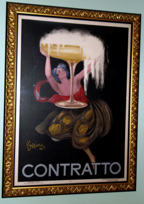Advertising Treasures
Popular Tags

Tuesday, March 12, 2019 in Education
by Tim Luke, ISA AM

Though stone lithography was invented in 1798, it took until almost 100 years later, or the later part of the 19th century, for the process to be used for advertising posters. French artist Jules Cheret pioneered the use of stone lithography. His use of vibrant colors coupled with dramatic images of women established his legacy as the father of advertising poster design. The eye-catching images attracted attention and served as the posters' focal point and the wording on the poster became secondary. This juxtaposition was effective in generating a "buzz" for events or a product.
Advertising posters of this genre were produced from the late 19th century through the mid-20th century. It was cheaper for the lithographer to produce posters in greater quantities, resulting in numerous posters plastered on billboards, town squares, kiosks, railroad stations, or any well-traveled public spaces. These enormous runs of posters at the time resulted in large quantities for fortunate collectors today.

As poster advertising became more popular, artists like Toulouse-Lautrec, Maxfield Parish, and Alphonse Mucha were commissioned to create images promoting commercial products. One of the most prolific artists, Leonetto Cappiello, an Italian working in France, was responsible for over 3,000 different poster designs during the first quarter of the 20th century. His whimsical style and eye-catching creations won him much acclaim, accounting for his popularity. The images in this blog post are of his designs.
Advertising posters were used to sell bicycles, automobiles, food, drink, and travel destinations and showcased vices like alcohol, tobacco, and chocolate. Vibrant colors and fanciful images drive collectors and decorators alike to ferret out these treasures at live auctions, online auctions, antiques shows, flea markets, and retail websites. More sophisticated collectors tend to focus on specific artists, subject matter, or rarity of original lithograph advertising posters. Original Lautrec posters have sold over the $100,000 mark while common posters can still be found in the $500 to 5,000 range with rare Cappiello posters selling at prices over $25,000.
As with a number of collecting genres, original advertising posters have been reproduced often within the past 30 or 40 years. The images are in the public domain so there is no limit to the amount of reproductions.
Tim's Poster Tips
- Large original posters usually measure 47 x 63 inches; reproductions will be smaller.
- Original stone lithography will not show a dot matrix under magnification.
- Original posters should be linen-backed for preservation.
- Original poster images were also used for smaller posters and cardboard or metal signs.
- Original common posters sell in the $500 to $5,000 range while reproductions sell in the $100 to $800 range.
- The value of a poster is determined by its image, artist, rarity, and wording. More wording means less value.
- Reproductions typically measure 36 x 48 inches or smaller.
- Reproductions show a dot matrix under magnification.
- Toulouse-Lautrec, Alphonse Mucha and Leonetto Cappiello images are frequently reproduced.
- Frame posters using an acid-free environment with UV Plexiglas to prevent fading.
Tim Luke, ISA AM, has 29 years of experience in the auction and appraisal industry. Currently, Tim is the Executive Vice President, Senior Appraiser for Gurr Johns, Inc., based in Florida and traveling the United States doing appraisals, valuations, and brokerage for clients.
